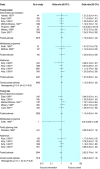Interventions to reduce unintended pregnancies among adolescents: systematic review of randomised controlled trials
- PMID: 12065267
- PMCID: PMC115855
- DOI: 10.1136/bmj.324.7351.1426
Interventions to reduce unintended pregnancies among adolescents: systematic review of randomised controlled trials
Abstract
Objective: To review the effectiveness of primary prevention strategies aimed at delaying sexual intercourse, improving use of birth control, and reducing incidence of unintended pregnancy in adolescents.
Data sources: 12 electronic bibliographic databases, 10 key journals, citations of relevant articles, and contact with authors.
Study selection: 26 trials described in 22 published and unpublished reports that randomised adolescents to an intervention or a control group (alternate intervention or nothing).
Data extraction: Two independent reviewers assessed methodological quality and abstracted data.
Data synthesis: The interventions did not delay initiation of sexual intercourse in young women (pooled odds ratio 1.12; 95% confidence interval 0.96 to 1.30) or young men (0.99; 0.84 to 1.16); did not improve use of birth control by young women at every intercourse (0.95; 0.69 to 1.30) or at last intercourse (1.05; 0.50 to 2.19) or by young men at every intercourse (0.90; 0.70 to 1.16) or at last intercourse (1.25; 0.99 to 1.59); and did not reduce pregnancy rates in young women (1.04; 0.78 to 1.40). Four abstinence programmes and one school based sex education programme were associated with an increase in number of pregnancies among partners of young male participants (1.54; 1.03 to 2.29). There were significantly fewer pregnancies in young women who received a multifaceted programme (0.41; 0.20 to 0.83), though baseline differences in this study favoured the intervention.
Conclusions: Primary prevention strategies evaluated to date do not delay the initiation of sexual intercourse, improve use of birth control among young men and women, or reduce the number of pregnancies in young women.
Figures





Comment in
-
Reducing unintended pregnancy among adolescents. Authors did not give balanced interpretation of their findings.BMJ. 2002 Oct 5;325(7367):777. doi: 10.1136/bmj.325.7367.777/a. BMJ. 2002. PMID: 12364317 Free PMC article. No abstract available.
-
Reducing unintended pregnancy among adolescents. Changes in social, economic, and educational policy need to be taken into account.BMJ. 2002 Oct 5;325(7367):777. BMJ. 2002. PMID: 12370966 No abstract available.
-
Review: primary prevention strategies do not delay initiation of intercourse, improve contraceptive use, or reduce pregnancies in adolescent women.Evid Based Nurs. 2003 Jan;6(1):13. doi: 10.1136/ebn.6.1.13. Evid Based Nurs. 2003. PMID: 12546031 No abstract available.
References
-
- DiCenso A, Van Dover LJ. Prevention of adolescent pregnancy. In: Stewart MJ, editor. Community nursing: promoting Canadians' health. 2nd ed. Toronto, ON: W B Saunders; 1999.
-
- Brown SS, Eisenberg L, editors. The best intentions: unintended pregnancy and the well-being of children and families. Washington, DC: National Academy Press; 1995. - PubMed
-
- Moore KA, Myers DE, Morrison DR, Nord CW, Brown B, Edmonston B. Age at first childbirth and later poverty. J Res Adolesc. 1993;3:393–422. - PubMed
-
- Geronimus AT, Korenman S. The socioeconomic consequences of teen childbearing reconsidered. Q J Economics. 1992;107:1187–1214.
-
- Stevens-Simon C, White MM. Adolescent pregnancy. Pediatr Ann. 1991;20:322–331. - PubMed
Publication types
MeSH terms
LinkOut - more resources
Full Text Sources
Medical
